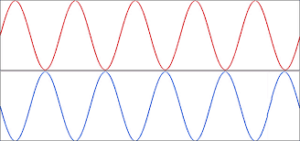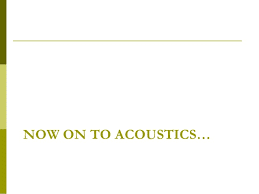This 4-part series of blogs overviews the phenomenon of masking and is written for the musician, not the audiologist. The first three parts (upwards spread of masking, downwards spread of masking, and temporal masking) relate to the function and structure of the cochlea and associated neural structures, whereas this last part (phase) refers to the acoustics of any room. Strictly speaking, phase issues are not related to “masking” in the typical sense but can be viewed as masking in a more general sense, since it can be responsible for a deletion of important information. In part 1, the characteristics of upwards spread of masking were discussed. In part 2, the phenomenon of downwards spread of masking was discussed. In part 3, temporal masking was discussed, and In this part, the beneficial and destructive characteristics of phase, are discussed.
I recall in the early 1990s, I was crossing a street in Stockhom, Sweden. Stockhom is a beautiful city but very expensive. At any rate, Stockhom was one of the first cities in the world to have auditory signals for people with low vision to assist in crossing the road. I recall pushing the crossing button and when the light turned green, a loud clicking began. And interesting it also began at the other side of street for those people with low vision to cross in the other direction.
About half way across the street, the clicking stopped. As I moved another couple of meters forward, the clicking began again. And of course, as I am an intrepid clinical scientist, I moved back and forth in the intersection, much to the dismay of the motorists who wanted to proceed but couldn’t because some idiot tourist seemed to be doing a dance in the middle of the intersection.
I tried to explain my excitement to a passing motorist but all I go was some unusual hand movements aimed in my direction. I presumed that this was the Swedish “hello”. I did this several times just to make sure that I wasn’t imagining things and received similar “hellos” from a range of motorists.
Of course I was experiencing destructive interference caused by the phase in the signal being exactly 180 degrees different than the phase emanating from the other side of the road. The signal was still there, merely being cancelled at that exact point in the busy intersection.
This was 1991 and despite the initial article about phase cancellation being in the literature since 1933, phase cancellation had not entered into the domain of noise control in cars, mechanical installations, or in hearing aids.
Destructive interference caused by an unfortunate confluence with phase and intensity (yes- intensity and not sound level) occurs everywhere from the study of room acoustics to the speech production of vowels and nasals, and from musical instruments to Swedish intersections.
Strictly speaking this is not masking in the sense of the first three parts of this blog series but destructive interference has the same effect – it alters the signal of what is being perceived, not by covering it up as in upwards spread of masking or temporal masking, but by reducing (or enhancing) a particular range of frequencies.
One of the most important parameters in the design of concert halls is to achieve the correct balance of incident and reflected waves. When the incident wave intersects an unfortunate reflected wave that happens to be about 180 out of phase and is of similar intensity, a null or quiet point can occur. I have heard of many cases where a musician can hear their own musical instrument quite well and then merely by tilting their head, creates a null or difference in the signal that enters their ear.

Sound waves interact with each other constructively where they add up and destructively where they can create nulls. Courtesy of www.uaudio.com
Of course these musical venues are well-known and musicians cringe when they are expected to perform there.
There are, however, a number of environmental modifications that can be made such as using a low hanging artificial ceiling (or cloud) over the performers to alter the phase relationship of the sound. These tend to be rather inexpensive and can significantly improve the musical experience for both the performer and the listener.
And like the various other forms of altering the speech and music that we hear, whether its by masking or by phase destruction, too little can be as bad as too much. A dead room with no reflections will not have any nulls caused by standing waves, but it also would be useless to listen to music and people talk.









